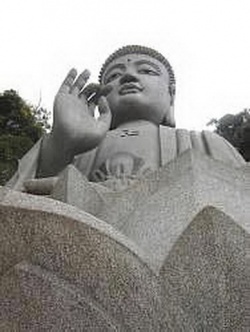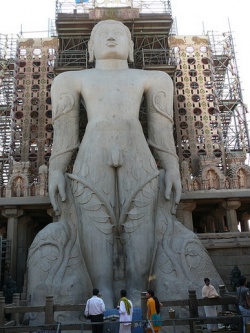Concerning the Three Truths
Lectures on Basic Study Materials (13)
from Dai-Byakuho
What are the Three Truths?
It is impossible to perceive the true nature of any given phenomenon from only a single aspect. It is likewise impossible to perfectly gain a complete grasp of a phenomenon from just two opposing aspects of it. Accordingly, to clarify any given phenomenon, it is necessary to have a third aspect, which, rather than being biased toward either of the other two opposing aspects, acts to fuse them. As a means of clarifying the true entity of all phenomena, the Great Master T’ien-t’ai explains these three aspects as the “Three Truths of Ku, Ke and Chu” (non-substantiality, temporary existence and the middle ground). He further explains that by practicing these Three Truths, one can sever oneself from the three categories of illusion illusions of thought and desire (kenji-waku), illusions as numerous as particles of dust and sand (jinga-waku) and illusions about the true nature of life (mumyo-waku). These three categories of illusion are explained to be the collective root of suffering. The word “truth” is also called “ascertaining truth,” which is “to fully know” or “to be apparent,” and signifies “truth that is not in vain,” This also means “truth that derives from the Buddha’s enlightenment.” The nomenclature “three truths” appears in the Nitai Chapter of the Ninno Sutra, while non-substantiality, temporary existence and the middle ground are mentioned by name in the ([[[Seigakkan]] (Shogakkan) Chapter of the Bosatsu Yoraku Hongo Sutra and the Shitai Chapter of the Chukan Ron. In relation to this, it is said that the Chinese priest Hokusai (also known as Emon Zenji) attained enlightenment to the Mystic Essence by reading the following passage from the Chukan Ron. “Causal relationship is the law through which all things come into being. The self is non-substantial, but it exists temporarily. But then again, the self signifies the middle path.” It is said that Hokusai passed this enlightenment on to his disciple Nan-yueh, who in turn transmitted it to the Great Master T’ien-t’ai.
Distinctiveness of the Three Truths
The Truth of Non-substantiality (Kutai) The Chinese character used for “non-substantiality” (ku) is usually understood in the Japanese language to mean “void,” “non-existent” or “devoid of.” For this reason Japanese are apt to think that “ku” means “void” (non existing). However, Buddhism explains that both phenomena that possess mindss well as phenomena that are devoid of minds all existence come into being through causal relationship. Buddhism further explains that the entities of all things that manifest through causal relationship are non-substantial. This explanation is called the concept of “ku” (non-substantiality). In short, the truth that no phenomenon is permanent is known as the “Truth of Non-substantiality.” The Great Master T’ien-t’ai explains that the concept of non- substantiality expounded in Hinayana Buddhism is a “fragmented concept of non-substantiality” because it uses analysis to observe that existence is non-substantial. He also explains that the Mahayana concept of non-substantiality is the “true concept of non- substantiality” because it observes with direct immediacy that existence itself is non-substantial. Further, because Hinayana Buddhism sees only the non-substantial aspect of existence, not recognizing its substantial side, the Hinayana concept is also called “Conditional Non-substantiality.” On the other hand, while Mahayana Buddhism sees all phenomena as non- substantial, it also acknowledges the substantial facet of existence, and is therefore known as “Unconditional Non-substantiality.”
The Truth of Temporary Existence (Ketai)
Although nothing maintains an absolute existential form, in reality, the distinct emergence of form is known as the “Truth of Temporary Existence.” Temporary existence is explained as a temporally hypothetical entity, which does not possess an absolute existence, but which, figuratively speaking, does exist. For that reason, the term “Temporary Existence” is used to mean the temporal existence of a phenomenon that is not substantive by nature. The Daihon Hannya Sutra explains three aspects of temporary existence, whereby all entities exist as temporary phenomena. 1. Objects are composed of a collection of many factors. (Receptive Temporary Existence) 2. Phenomena themselves are derivations from causal relationships. (Phenomenal Temporary Existence) 3. All things exists in name only. (Nominal Temporary Existence) These three aspects indicate that nothing possesses a true “self nature” (an object’s substantive character), which frees us from bondage to our common mortality.
The Truth of the Middle Way (Chutai)
The reasoning behind a correct middle ground that remains unbiased toward either of the two extremes of non-substantiality and temporary existence is known as the “Truth of the Middle Way.” More precisely, all phenomena are non-substantial because they exist through causal relationship, but only within the confines of limited time frames. Then again, because non-substantiality is not a fixed reality, non-substantiality itself can be said to be non- substantial. Therefore, that unopposing area, where one finds true reason that rejects both non-substantiality and temporary existence, is known as the Middle Way, or the Middle Path. The Middle Path is not a self-compromising concept, as if caught between a rock and hard place. Rather, it is a truth that is able to incorporate within itself the truths of both non-substantiality and temporary existence. When the Middle Path is viewed with the overlay of the Four Teachings, the following nomenclatures result: “Negation of the Middle Path,” “Inclusion of the Middle Path,” “Conditional Middle Path,” and “Unconditional Middle Path.” The doctrine of the middle path is not to be found within Hinayana Buddhism (Zokyo/Tripitaka teachings), and hence, the name “Negation of the Middle Path” is appended. The connecting teaching (Tsugyo), or the introductory Mahayana teaching, incorporates the doctrine of the middle path. That is the reason for the term “Inclusion of the Middle Path.” The specific teaching (Bekkyo), a more profound level of Mahayana Buddhism, only expounds the middle path as a doctrine unrelated to non-substantiality and temporary existence, which is why the nomenclature “Conditional Middle Path” is used. The perfect teaching (Engyo), or true Mahayana teaching, expounds the perfectly endowed middle path contained in the Three Truths. Thus, it is called the “Unconditional Middle Path.”
The Three Distinct and Successive Truths, and Perfect Endowment There are two ways of looking at the Three Truths. One way is to think of each of the Three Truths as an individual and independent truth. These are known as the Three Distinct and Successive Truths. The second way is to discard the concept of the isolated character of the Three Truths to form the concept that each single truth is mutually endowed with the Three Truths, with each truth embodying both non-substantiality, temporary existence and the middle ground. This doctrine is the Three Perfectly Endowed Truths. The Three Distinct and Successive Truths are also referred to as the Three Ordered Truths, meaning that each of the Three Truths is distinct. That is, the truth of non-substantiality is only non- substantiality, including neither temporary existence nor the middle way. In the same way, the truth of temporary existence is solely temporary existence, but is neither non-substantiality nor the middle way. Again, the middle way is only the middle way, inclusive of neither non-substantiality nor temporary existence. This doctrine is expounded in higher Mahayana Buddhism (Bekkyo). In contrast to this, in the Three Perfectly Endowed Teachings, the three truths of non-substantiality, temporary existence and the middle way are mutually infused, with each truth inclusive of the other two. That is, it is explained that the truth of non-substantiality is natually the truth of both temporary existence and the middle way. The truth of temporary existence is naturally the truth of both nonsubstantialty and the truth of the middle way. Further, the truth of the middle way is naturally the truths of both non-substantiality and temporary existence. The principle of the Three Perfectly Endowed Truths is called the Perfect Teaching (Engyo). The Great Master T’ien-t’ai established the practice of the Three Observations in a Single Mind. Observing the Three Truths is known as the Three Observations. The principle of clear perception derived from the Three Perceptions in a Single Mind, which perceives that the moment to moment mind of the common man is itself the Three Perfectly Endowed Truths, is the principle of ichinen sanzen (three thousand realms in a single mind).
The Ongi Kuden states:
The three truths of perfect endowment are none other than Nam- Myoho-Renge-Kyo. These five characters are the true reason for Nichiren’s advent in the world. (Shinpen, p. 1729) Nichiren Daishonin established the Dai-Gohonzon of the Three Great Secret Laws, both as the path for the observance of ichinen sanzen established by T’ien-T’ai, and for the true practice that enables people in the Latter Day of the Law to immediately attain an enlightened life condition.


